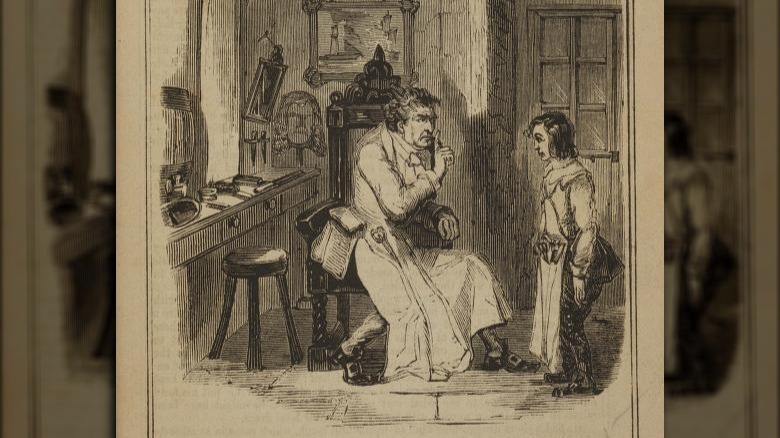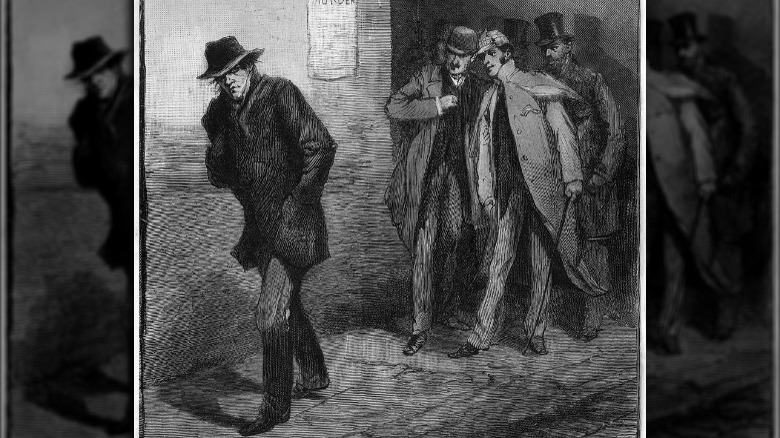Notorious Serial Killers Who May Have Never Existed
It's difficult to turn away from stories of serial killers. They are darkly compelling, presenting lurid and shocking tales that prove difficult to ignore, as much as they might horrify us. Perhaps that's why the true crime genre is again growing in popularity, though it's worth noting that tales of bloody and vicious killers have been drawing our shocked attention for centuries, according to JSTOR Daily.
Suffice it to say, it's easy to get sucked into seemingly endless tales of murder and mayhem. Readers with a tendency towards the paranoid might even be convinced that there are serial killers lurking around every corner, waiting to wreak havoc on the innocent and undermine society at large.
But take heart. For, while there are indeed real serial murderers out there, the truth is that they're on a serious decline (via Discover Magazine). What's more, quite a few of them may have never existed in the first place. Whether their stories contain a grain of truth or are totally fictional, some of the most notorious stories of serial killers are actually made from nothing at all.
Many are skeptical about the Smiley Face Killer's existence
Some true crime theories help to perpetuate themselves not because of the strength of the evidence contained therein, but because they present nothing more than an interesting narrative. The truth of that narrative often seems to be a secondary concern.
Take the case of the Smiley Face Killer. The murderer in question was once widely believed to be an active serial killer who operated in New York City, says A&E. Said killer would grab young men from bars or parties and then, after what was presumed to be a period of torture, would drown them in local waterways. The "smiley face" link came from what many believed to be significant instances of smiley face graffiti found near the bodies. The theory soon spread to numerous other regions, including Ohio, Pennsylvania, and Iowa.
Only, upon closer examination, the situation was far too broadly defined and more easily explained by other factors. Many began to argue that the men who had died could have accidentally drowned, especially considering that many appeared to be under the influence of alcohol or drugs at the time of their death. The cases were further complicated by police officials who perhaps didn't want to admit that they'd gotten caught up in a compelling, but poorly supported story, as well as grieving families who weren't ready to accept an accident as the cause of their loved ones' deaths. Ultimately, there is no known Smiley Face Killer.
Sweeney Todd is a fascinating musical murderer who didn't exist
"Sweeney Todd: The Demon Barber of Fleet Street" is a long-running Broadway musical penned by Stephen Sondheim that's been appearing on stages and occasionally big and small screens since its premiere in 1979 (via Playbill). The musical was based on earlier stories of a murderous barber who operated in London long ago. But was Sweeney Todd real, as some have wondered? It certainly seems like it could have happened. Men of 19th century London did visit barbers, who wielded wickedly sharp straight razors that could have easily been used by a malicious person to cut a throat. And it's not like 19th century police had the kind of resources to track every missing person in the city. So, is there a string of murdered or missing men from that time and place who also happened to visit the Demon Barber?
Not really. According to PBS, the first known appearance of Sweeney Todd comes via an 1846 "penny dreadful," a sensationalist, cheaply produced tale of terror that can't exactly be taken as substantiated fact. And researchers who have dug into the historic record can't find a telltale trail of dead or missing people. In fact, they can't even find confirmation that a barber worked on London's real Fleet Street in the early to mid-19th century. While it's true that some penny dreadfuls were dramatizations of real crimes, it appears that Sweeney Todd only exists on the page and the stage.
The Halifax Slasher was the product of a mass panic
Too often, it's difficult to parse just what's true and what is the product of a confused and anxious human mind. And when you realize that you're dealing with not just one easily misled person, but many, things get even more complicated. Sometimes, they can even turn dangerous.
Take the case of the Halifax Slasher. According to The Yorkshire Post, this serial killer was first identified in northern England in 1938. Two women in the town of Halifax claimed to have been attacked by a mysterious man wielding a mallet and, curiously, sporting brightly shining buckles on his shoes. Another woman later came forward with a similar story.
Soon enough, groups of concerned citizens were forming ad-hoc security groups. That could have been fine, except they apparently weren't any good at identifying the potential serial killer in their midst. They attacked a number of innocent men, dealing out real-world violence. Meanwhile, more and more people began to panic, and some businesses even closed temporarily to avoid the violence. Eventually, officers from Scotland Yard were called in. Yet, a mere week after the initial reports, skepticism began to take over. No bodies were recovered, no further attacks were reported, and no murderer with shiny shoe buckles and a hammer was ever apprehended. It was all soon dismissed as a case of mass hysteria.
Henry Lee Lucas was violent criminal who wasn't as deadly as he claimed
There's no doubt that Henry Lee Lucas was a dangerous man who committed shocking and violent crimes, including murder. Indeed, he's often classified as a serial killer, having been convicted of the deaths of 11 people, per Biography. Yet, as some argued, he may have been even more violent than that, with hundreds of victims instead.
After his apprehension and detention in the 1980s, Henry Lee Lucas began to confess. And, while some of his statements were linked to actual murders that had been committed by Lucas, others were eventually found to be false. But, at first, it may have seemed that Lucas was the most prolific serial killer in history. According to The Journal of Forensic Psychiatry, Lucas confessed to over 600 murders. Officers from across the nation subsequently interviewed Lucas and a special investigative task force was set up through the Texas Rangers.
Some said Lucas had "special knowledge" that no one but the killer could know, but others later testified that Texas Rangers had actually revealed sensitive information to him. Furthermore, Lucas may have been lying to gain special privileges. And some of his confessions were downright unbelievable, like the claim that he had been part of a secretive serial killer cult that met in rural Florida to plot murders and consume human flesh (via The Oklahoman). No evidence of such an extensive network of bloody cultists has ever been uncovered.
Lucian Staniak was almost certainly a complete fabrication
Many true crime sources will report on the case of the Polish serial killer known as the "Red Spider" as if it were a verifiable fact. He's even appeared in textbooks like "Serial Killers Around the World," which reports that the Red Spider was a man known as Lucian Staniak who killed along mass transit lines. He's even believed to have gone so far as to murder victims right inside train cars, seemingly careless of the danger that he would be caught in the act. He's even had a film made about him, titled, naturally enough, "The Red Spider."
Staniak, however, likely didn't care about being caught because he was never real to begin with. According to a film review for "The Red Spider" in Variety, there's practically no evidence to support the Red Spider story. Indeed, Variety reported that the press notes for the film admitted that Staniak wasn't real. Perhaps most tellingly, no one's been able to produce police reports or court records that, for other known serial killers, usually supports the claim that they're real.
The Phantom of Heilbronn was a testing error
For 15 years, German police thought they had a major case on their hands. Not only was there an unidentified killer leaving DNA around at least six murder scenes, but that serial killer was a woman. According to Discover Magazine, female serial killers do exist, but they appear to be far more rare than their male counterparts and often have different techniques and motivations, like using poison or killing those closest to them. Yet, with the violent unsolved murders of unconnected people in Germany, it appeared that this particular killer was prepared to stand out. If only investigators could identify her, though. She was dubbed the "Phantom of Heilbronn," after a city where she was believed to have killed at least one person.
Then, they looked a little closer at the DNA. While this sort of evidence is typically pretty ironclad, it's not infallible. And, as the BBC reports, there was a significant flaw here. Sure, there were up to 40 crime scenes that had at least traces of the same woman's DNA. But the traces were oddly inconsistent, showing up on some pieces of evidence and not others, though the samples were all from the same scene.
Eventually, investigators determined that the cotton swabs used to collect evidence had been contaminated by an innocent factory worker. The "Phantom of Heilbronn" wasn't just nonexistent but had distracted the police from finding the real killers for well over a decade.
Elizabeth Bathory could have been framed for serial murder
Elizabeth Bathory is one of the most notorious figures in all of true crime. Per Biography, she was a fabulously wealthy and powerful Hungarian countess born in the 16th century. But it all came tumbling down when, in 1610, authorities claimed that she had been murdering hundreds of young women from the area around her castle for years. Some of the most lurid tales maintained that she not only tortured the women but bathed in their blood in a misguided attempt to regain her youth. Bathory was subsequently placed on house arrest and died in her castle in 1614.
Yet, there are significant flaws with her story. Count György Thurzó, the man who oversaw her trial, may have had an interest in taking down a female rival. Furthermore, lurid testimony from some of her closest servants was taken only after they were tortured and gave statements under duress. And significant pieces of evidence, like direct witnesses to her crimes or those hundreds of bodies, remained missing.
This isn't to say that Elizabeth was instead the picture of Christian charity and kindness. Per SyFy, a minister had already publicly censured Bathory for her cruelty (though said minister was Lutheran and may have had a grudge against the Calvinist Bathory). But the evidence pinning her as a serial killer is scant indeed. It could be instead that she was an inconveniently powerful woman who was dramatically taken out by her rivals.
Wearside Jack distracted police from a real serial killer
In 1970s Yorkshire, there was a genuine serial killer who was stalking the countryside. The Yorkshire Ripper, eventually revealed to be a man named Peter Sutcliffe, was apprehended and convicted in 1981, per the BBC. He's known to have killed 13 women over a five-year period, during which time people throughout northern England and the rest of the U.K. wondered just who amongst them was committing the brutal murders.
The police were stymied too, not just by the viciousness and complexity of the case, but also by a notorious hoax that fooled them for a time and arguably took valuable attention away from finding the real killer. It all started around 1979, the BBC reports, when police received a letter and tapes that seemed to have come from the killer. Yorkshire Police went after the mysterious suspect, dubbed "Wearside Jack." It's now believed that the delay caused by this fruitless side investigation allowed Sutcliffe to kill three more women.
But while investigators eventually realized that Wearside Jack was a fake, they didn't apprehend the hoaxer until 2005. That's when DNA from one of the envelopes containing the Wearside Jack letters was linked to a man named John Humble, who admitted to the whole thing. He was subsequently arrested and imprisoned until 2009.
Thomas Quick lied about his crimes
Collecting testimony from an alleged serial killer is a notoriously tricky business. Some, it seems, are excited by the idea of notoriety or even just the chance to take a field trip from jail and lead investigators on a wild goose chase as they identify supposed crime sites. Murderer Henry Lee Lucas even became known as a notorious liar for his seemingly unending stream of admissions, though there's little proof that he killed the hundreds of women that he confessed to killing (via Vulture).
This isn't a distinctly American phenomenon, either. Take the case of Swedish criminal Thomas Quick. According to The Guardian, police in the 1990s may have initially thought that they were on the case of one of the worst mass murderers in the nation — at least, if they believed Quick's confessions. He confessed to shocking crimes that involved 30 bloody, cannibalistic killings and was convicted of eight.
Then, he abruptly stopped talking to police and reverted to his birth name of Sture Bergwall. A closer look by investigators revealed that, in many cases, there was no evidence connecting Bergwall to the crimes. In fact, some witnesses provided solid alibis for the supposed killer, making it all but impossible for him to have killed some of the victims. Bergwall finally admitted that he'd made up all of his confessions. Bergwall was moved to a mental institution, his convictions were eventually overturned, and he was released in 2014 (via BBC).
Some investigators think there were multiple Jack the Rippers
Few serial killer cases have been quite as picked over as that of Jack the Ripper, the unidentified murderer who stalked the Whitechapel district of London in 1888, brutally murdering at least five sex workers and indigent women over the course of two months (via History). Most people have assumed that the central five murders, and perhaps a few more, were all committed by a single individual with some knowledge of human anatomy and a horrifying drive to mutilate vulnerable women.
In the many decades since the murders, professional and amateur investigators alike have come up with what can seem like a vast universe of theories centering on the killer's identity. Yet, one of the most surprising suggests that "Jack the Ripper" wasn't one killer, but multiple.
It's a pretty bold theory in a field that's already crowded with different ideas, but one that holds some interest. The Telegraph notes that investigators in 1888 weren't uniformly convinced that all of the central five murders shared enough details to indicate they were committed by the same person. It's possible that some of the murders were committed by "copycat" killers seeking to go undetected while everyone was searching for a different murderer.
The gruesome Salish Sea feet were like the results of accidents, not a killer
For a period of time beginning around 2007, it may have seemed like a very strange serial killer was operating in the Salish Sea region of the Pacific Northwest near Vancouver, Canada. According to Vox, that's when hikers and beachgoers started finding shoes around the coast there — with the feet still inside. The number of gruesome shoe discoveries began to seemingly pile up, with more and more disembodied, decomposing feet in shoes found over the years. Was there a serial killer on the loose? And why would they leave behind such a uniquely gruesome hallmark?
Only, once people moved past the wild tales and conspiracy theories, it became pretty clear that there was no serial killer happening. Instead, the remains seemed to be linked to missing people who were more likely to have drowned in local waterways. The natural decomposition process, complete with relatively cold water, scavenging sea life, and buoyant sneaker material, all meant that feet easily detached from the rest of the body and floated. Currents eventually carried some of these body parts to the coast, where they were discovered. A touch of sensationalist press did the rest of the work.
The CBC notes that, so far, none of the cases show any evidence of foul play. And, while some cases do remain unsolved, it seems highly unlikely that there's a foot-hacking serial killer at work in the coastal Pacific Northwest.











